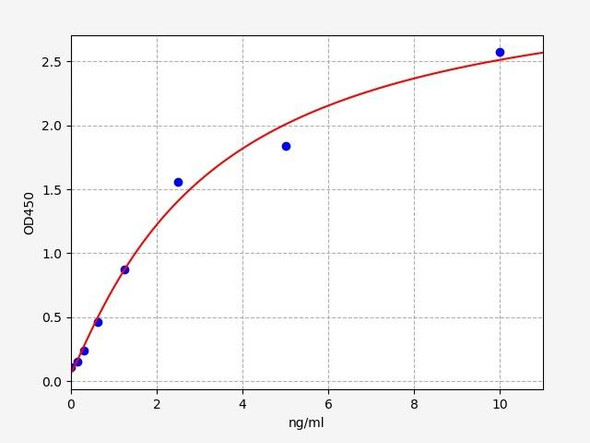Human BANP (BTG3 Associated Nuclear Protein) ELISA Kit (HUES03297)
- SKU:
- HUES03297
- Product Type:
- ELISA Kit
- Size:
- 96 Assays
- Uniprot:
- Q8N9N5
- Sensitivity:
- 0.09ng/mL
- Range:
- 0.16-10ng/mL
- ELISA Type:
- Sandwich
- Reactivity:
- Human
- Sample Type:
- Serum, plasma and other biological fluids
- Research Area:
- Cell Cycle
Description
Human BANP (BTG3 Associated Nuclear Protein) ELISA Kit
The Human BANP (BTG3 Associated Nuclear Protein) ELISA Kit is specifically designed for the precise quantification of BANP levels in human samples including serum, plasma, and cell culture supernatants. This advanced kit offers exceptional sensitivity and specificity, guaranteeing accurate and consistent results for a variety of research purposes.BANP, also known as BTG3 Associated Nuclear Protein, is a key protein involved in various cellular processes including DNA repair, transcriptional regulation, and cell cycle control.
Abnormalities in BANP levels have been associated with cancer, neurodevelopmental disorders, and other serious conditions, highlighting the importance of studying this protein as a potential biomarker for disease diagnosis and treatment development.With the Human BANP ELISA Kit, researchers can confidently study the role of BANP in various diseases and contribute to the advancement of medical knowledge and therapeutic interventions.
| Assay type: | Sandwich |
| Format: | 96T |
| Assay time: | 4.5h |
| Reactivity: | Human |
| Detection Method: | Colormetric |
| Detection Range: | 0.16-10 ng/mL |
| Sensitivity: | 0.10 ng/mL |
| Sample Volume Required Per Well: | 100µL |
| Sample Type: | Serum, plasma and other biological fluids |
| Specificity: | This kit recognizes Human BANP in samples. No significant cross-reactivity or interference between Human BANP and analogues was observed. |
This ELISA kit uses Sandwich-ELISA as the method. The micro ELISA plate provided in this kit has been pre-coated with an antibody specific to Human BANP. Standards or samples are added to the appropriate micro ELISA plate wells and combined with the specific antibody. Then a biotinylated detection antibody specific for Human BANP and Avidin-Horseradish Peroxidase (HRP) conjugate are added to each micro plate well successively and incubated. Free components are washed away. The substrate solution is added to each well. Only those wells that contain Human BANP, biotinylated detection antibody and Avidin-HRP conjugate will appear blue in color. The enzyme-substrate reaction is terminated by adding Stop Solution and the color turns yellow. The optical density (OD) is measured spectrophotometrically at a wavelength of 450 nm ± 2 nm. The OD value is proportional to the concentration of Human BANP. The concentration of Human BANP in samples can be calculated by comparing the OD of the samples to the standard curve.
| UniProt Protein Function: | BANP: Controls V(D)J recombination during T-cell development by repressing T-cell receptor (TCR) beta enhancer function. Binds to scaffold/matrix attachment region beta (S/MARbeta), an ATC-rich DNA sequence located upstream of the TCR beta enhancer. Represses cyclin D1 transcription by recruiting HDAC1 to its promoter, thereby diminishing H3K9ac, H3S10ph and H4K8ac levels. Promotes TP53 'Ser-15' phosphorylation and nuclear accumulation, which causes cell cycle arrest. Belongs to the BANP/SMAR1 family. 6 isoforms of the human protein are produced by alternative splicing. |
| UniProt Protein Details: | Protein type:Tumor suppressor Chromosomal Location of Human Ortholog: 16q24 Cellular Component: nucleoplasm Molecular Function:protein binding; DNA binding; p53 binding Biological Process: transcription, DNA-dependent; regulation of transcription, DNA-dependent; multicellular organismal development; chromatin modification; negative regulation of protein catabolic process; cell cycle |
| NCBI Summary: | This gene encodes a protein that binds to matrix attachment regions. The protein forms a complex with p53 and negatively regulates p53 transcription, and functions as a tumor suppressor and cell cycle regulator. Multiple transcript variants encoding different isoforms have been found for this gene. [provided by RefSeq, Mar 2010] |
| UniProt Code: | Q8N9N5 |
| NCBI GenInfo Identifier: | 308153628 |
| NCBI Gene ID: | 54971 |
| NCBI Accession: | Q8N9N5. 3 |
| UniProt Related Accession: | Q8N9N5 |
| Molecular Weight: | |
| NCBI Full Name: | Protein BANP |
| NCBI Synonym Full Names: | BTG3 associated nuclear protein |
| NCBI Official Symbol: | BANP |
| NCBI Official Synonym Symbols: | BEND1; SMAR1; SMARBP1 |
| NCBI Protein Information: | protein BANP |
| UniProt Protein Name: | Protein BANP |
| UniProt Synonym Protein Names: | BEN domain-containing protein 1; Btg3-associated nuclear protein; Scaffold/matrix-associated region-1-binding protein |
| Protein Family: | Protein |
| UniProt Gene Name: | BANP |
| UniProt Entry Name: | BANP_HUMAN |
As the OD values of the standard curve may vary according to the conditions of the actual assay performance (e. g. operator, pipetting technique, washing technique or temperature effects), the operator should establish a standard curve for each test. Typical standard curve and data is provided below for reference only.
| Concentration (ng/mL) | O.D | Average | Corrected |
| 10 | 2.386 2.432 | 2.409 | 2.335 |
| 5 | 1.663 1.713 | 1.688 | 1.614 |
| 2.5 | 0.961 0.949 | 0.955 | 0.881 |
| 1.25 | 0.51 0.532 | 0.521 | 0.447 |
| 0.63 | 0.273 0.245 | 0.259 | 0.185 |
| 0.32 | 0.188 0.166 | 0.177 | 0.103 |
| 0.16 | 0.119 0.135 | 0.127 | 0.053 |
| 0 | 0.064 0.084 | 0.074 | -- |
Precision
Intra-assay Precision (Precision within an assay): 3 samples with low, mid range and high level Human BANP were tested 20 times on one plate, respectively.
Inter-assay Precision (Precision between assays): 3 samples with low, mid range and high level Human BANP were tested on 3 different plates, 20 replicates in each plate.
| Intra-assay Precision | Inter-assay Precision | |||||
| Sample | 1 | 2 | 3 | 1 | 2 | 3 |
| n | 20 | 20 | 20 | 20 | 20 | 20 |
| Mean (ng/mL) | 0.51 | 1.19 | 3.53 | 0.51 | 1.28 | 3.60 |
| Standard deviation | 0.03 | 0.06 | 0.11 | 0.03 | 0.06 | 0.15 |
| C V (%) | 5.88 | 5.04 | 3.12 | 5.88 | 4.69 | 4.17 |
Recovery
The recovery of Human BANP spiked at three different levels in samples throughout the range of the assay was evaluated in various matrices.
| Sample Type | Range (%) | Average Recovery (%) |
| Serum (n=5) | 93-106 | 99 |
| EDTA plasma (n=5) | 94-109 | 102 |
| Cell culture media (n=5) | 95-109 | 101 |
Linearity
Samples were spiked with high concentrations of Human BANP and diluted with Reference Standard & Sample Diluent to produce samples with values within the range of the assay.
| Serum (n=5) | EDTA plasma (n=5) | Cell culture media (n=5) | ||
| 1:2 | Range (%) | 86-99 | 90-107 | 93-107 |
| Average (%) | 91 | 98 | 99 | |
| 1:4 | Range (%) | 93-108 | 82-95 | 83-97 |
| Average (%) | 100 | 87 | 90 | |
| 1:8 | Range (%) | 88-103 | 84-97 | 85-98 |
| Average (%) | 96 | 89 | 90 | |
| 1:16 | Range (%) | 90-105 | 80-92 | 84-95 |
| Average (%) | 96 | 86 | 90 |
An unopened kit can be stored at 4°C for 1 month. If the kit is not used within 1 month, store the items separately according to the following conditions once the kit is received.
| Item | Specifications | Storage |
| Micro ELISA Plate(Dismountable) | 8 wells ×12 strips | -20°C, 6 months |
| Reference Standard | 2 vials | |
| Concentrated Biotinylated Detection Ab (100×) | 1 vial, 120 µL | |
| Concentrated HRP Conjugate (100×) | 1 vial, 120 µL | -20°C(shading light), 6 months |
| Reference Standard & Sample Diluent | 1 vial, 20 mL | 4°C, 6 months |
| Biotinylated Detection Ab Diluent | 1 vial, 14 mL | |
| HRP Conjugate Diluent | 1 vial, 14 mL | |
| Concentrated Wash Buffer (25×) | 1 vial, 30 mL | |
| Substrate Reagent | 1 vial, 10 mL | 4°C(shading light) |
| Stop Solution | 1 vial, 10 mL | 4°C |
| Plate Sealer | 5 pieces | |
| Product Description | 1 copy | |
| Certificate of Analysis | 1 copy |
- Set standard, test sample and control (zero) wells on the pre-coated plate and record theirpositions. It is recommended to measure each standard and sample in duplicate. Note: addall solutions to the bottom of the plate wells while avoiding contact with the well walls. Ensuresolutions do not foam when adding to the wells.
- Aliquot 100µl of standard solutions into the standard wells.
- Add 100µl of Sample / Standard dilution buffer into the control (zero) well.
- Add 100µl of properly diluted sample (serum, plasma, tissue homogenates and otherbiological fluids) into test sample wells.
- Cover the plate with the sealer provided in the kit and incubate for 90 min at 37°C.
- Aspirate the liquid from each well, do not wash. Immediately add 100µL of BiotinylatedDetection Ab working solution to each well. Cover the plate with a plate seal and gently mix. Incubate for 1 hour at 37°C.
- Aspirate or decant the solution from the plate and add 350µL of wash buffer to each welland incubate for 1-2 minutes at room temperature. Aspirate the solution from each well andclap the plate on absorbent filter paper to dry. Repeat this process 3 times. Note: a microplatewasher can be used in this step and other wash steps.
- Add 100µL of HRP Conjugate working solution to each well. Cover with a plate seal andincubate for 30 min at 37°C.
- Aspirate or decant the solution from each well. Repeat the wash process for five times asconducted in step 7.
- Add 90µL of Substrate Reagent to each well. Cover with a new plate seal and incubate forapproximately 15 min at 37°C. Protect the plate from light. Note: the reaction time can beshortened or extended according to the actual color change, but not by more than 30min.
- Add 50 µL of Stop Solution to each well. Note: Adding the stop solution should be done inthe same order as the substrate solution.
- Determine the optical density (OD value) of each well immediately with a microplate readerset at 450 nm.








